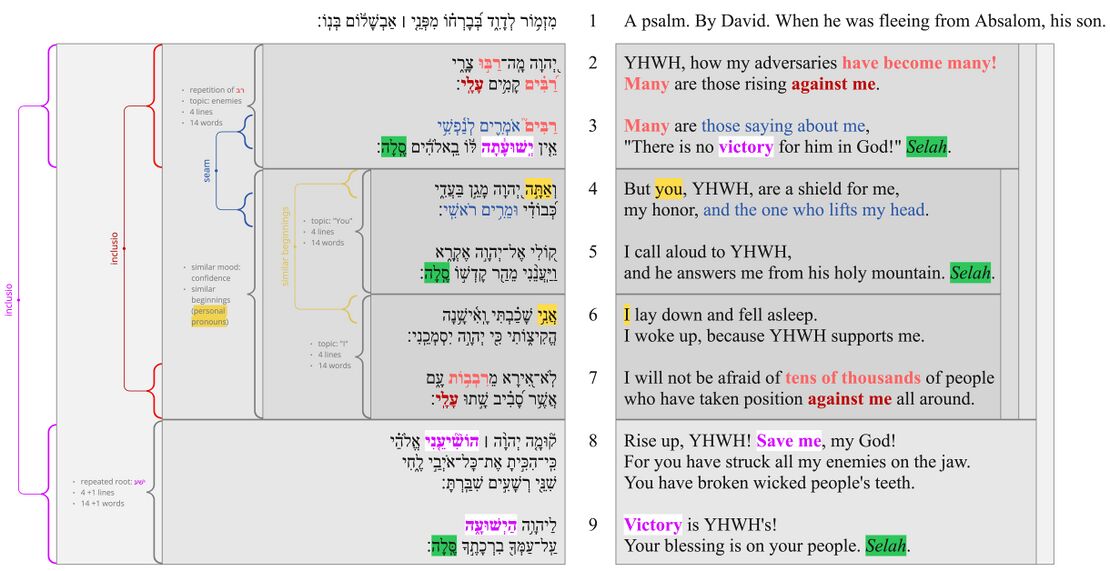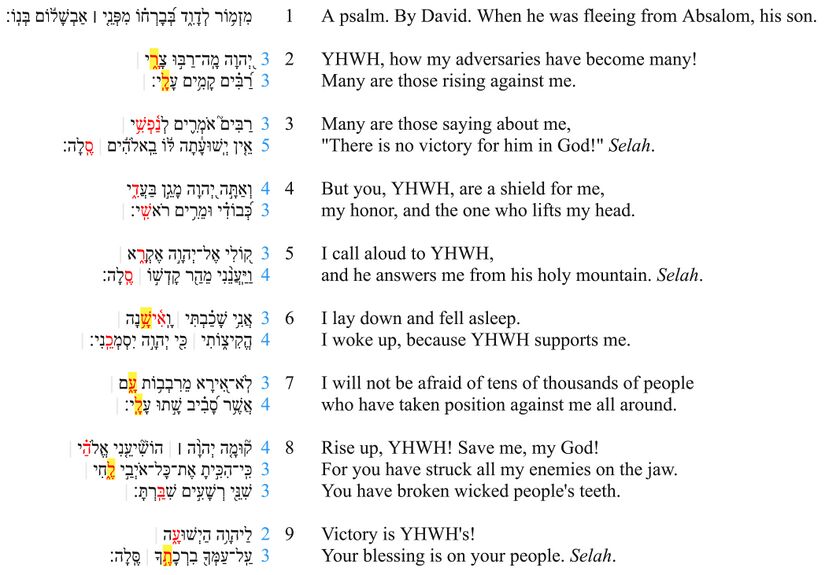Psalm 3 Poetic Structure
Poetic Structure
In poetic structure, we analyse the structure of the psalm beginning at the most basic level of the structure: the line (also known as the “colon” or “hemistich”). Then, based on the perception of patterned similarities (and on the assumption that the whole psalm is structured hierarchically), we argue for the grouping of lines into verses, verses into sub-sections, sub-sections into larger sections, etc. Because patterned similarities might be of various kinds (syntactic, semantic, pragmatic, sonic) the analysis of poetic structure draws on all of the previous layers (especially the Discourse layer).
Poetic Macro-structure
If an emendation or revocalization is preferred, that emendation or revocalization will be marked in the Hebrew text of all the visuals.
| Emendations/Revocalizations legend | |
|---|---|
| *Emended text* | Emended text, text in which the consonants differ from the consonants of the Masoretic text, is indicated by blue asterisks on either side of the emendation. |
| *Revocalized text* | Revocalized text, text in which only the vowels differ from the vowels of the Masoretic text, is indicated by purple asterisks on either side of the revocalization. |
|
v. 1 A psalm. By David. When he was fleeing from Absalom, his son. |
Superscription |
|||
|
v. 2 YHWH, how my adversaries have become many! Many are those rising against me. |
Attack |
Many are rising against me. |
dismay |
|
|
v. 3 Many are those saying about me, There is no victory for him in God!" Selah. |
||||
|
v. 4 But you, YHWH, are a shield for me, my honor, and the one who lifts my head. |
Defense |
But you, YHWH, are a shield for me… |
confidence |
|
|
v. 5 I call aloud to YHWH, and he answers me from his holy mountain. Selah. |
||||
|
v. 6 I lay down and fell asleep. I woke up, because YHWH supports me. |
||||
|
v. 7 I will not be afraid of tens of thousands of people who have taken position against me all around. |
||||
|
v. 8 Rise up, YHWH! Save me, my God! For you have struck all my enemies on the jaw. You have broken wicked people's teeth. |
Victory |
Rise and save me, my God! |
triumph |
|
|
v. 9 Victory is YHWH's! Your blessing is on your people. Selah. |
||||
Notes
- The psalm divides into four sections (vv. 2-3, 4-5, 6-7, 8-9).[1] Other scholars have argued for a division into three sections (vv. 2-4, 5-7, 8-9).[2] In our view, the division into four sections better accounts for the discourse markers and repetitions in the psalm than the division into three sections (see notes below). Scholars who argue for the three-section division are right to note the continuity between v. 3 and v. 4 (see esp. the similar sounds between אֹמְרִ֪ים לְנַ֫פְשִׁ֥י and וּמֵרִ֥ים רֹאשִֽׁי; also the 2nd person address to YHWH), but this continuity is not strong enough to override the strong discontinuity between v. 3 and v. 4. Instead, the continuity functions at a higher level, creating a seam across disparate sections, binding the first section (vv. 2-3) to the two middle sections (vv. 4-7).
- The four-fold division is supported by the following:
- It accounts for obvious shifts in topic, emotion, and speech act:
- vv. 2-3—topic: enemies; emotion: distress; speech act: describing the distressing situation
- vv. 4-5—topic: YHWH ("You"); emotion: confidence; speech act: declaring confidence in YHWH
- vv. 6-7—topic: David ("I"); emotion: confidence; speech act: demonstrating confidence in YHWH
- vv. 8-9—topic: YHWH; emotion: confidence, triumph; speech act: asking YHWH to help.
- It accounts for the occurrences of selah, which helps to mark the end of sections 1, 2, and 4 (vv. 3b, 5b, 9b).
- It accounts for the occurrences of the divine name as a vocative, at the beginning of sections 1, 2, and 4 (vv. 2a, 4a, 8a).
- It results in a balanced structure. Each section is near the same length (4 lines, 14 words / 4 lines, 14 words / 4 lines, 14 words / 4+1 lines, 14+1 words). It is interesting to note that the recurring number 14 is the numerical value of David's name: dalet = 4; waw = 6; dalet = 4[3]).
- It accounts for the most striking repetitions and similarities in the psalm.
- The first section is bound together by similar content (repetition of root רבב, enemies as topic) as well as a possible inclusio ("YHWH... God").
- The second and third sections share similar beginnings; both begin with an independent personal pronoun (v. 4a: "you;" v. 6a: "I"). "You" (= YHWH) is the topic of the second section (vv. 4-5). "I" (= David) is the topic of the third section (vv. 6-7). These two sections also share a similar mood (confidence) and have a similar rhetorical function (declaring/demonstrating confidence in YHWH).
- The first section (vv. 2-3) and the two middle sections (vv. 4-7) are bound together by an inclusio (vv. 2, 7: "many... against me") and by a phonological seam (vv. 3-4, similar sounds between אֹמְרִ֪ים לְנַ֫פְשִׁ֥י and וּמֵרִ֥ים רֹאשִֽׁי).
- The final section (vv. 8-9) is bound together by the repetition of the root ישע (vv. 8a, 9a) and by its total word-count (15 words) which closely matches that of the previous sections. (The preceding sections create an expectation for a section of similar length.) The beginning of the final section is marked by the appearance of a three-line verse (v. 8) and a cluster of imperatives and a vocative (v. 8a). The final section also parallels the first section (vv. 2-3) in a number of ways. (See Poetic Features.)
- It accounts for obvious shifts in topic, emotion, and speech act:






